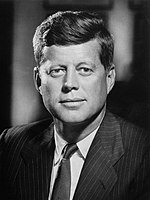
Back انتخابات الرئاسة الأمريكية 1960 Arabic Президентски избори в САЩ (1960) Bulgarian ھەڵبژاردنی سەرۆکایەتیی ویلایەتە یەکگرتووەکانی ئەمریکا (١٩٦٠) CKB Præsidentvalget i USA 1960 Danish Präsidentschaftswahl in den Vereinigten Staaten 1960 German Προεδρική εκλογή των Ηνωμένων Πολιτειών 1960 Greek Elecciones presidenciales de Estados Unidos de 1960 Spanish انتخابات ریاستجمهوری ایالات متحده آمریکا (۱۹۶۰) Persian Yhdysvaltain presidentinvaalit 1960 Finnish Élection présidentielle américaine de 1960 French
| |||||||||||||||||||||||||||||
537 members of the Electoral College 269 electoral votes needed to win | |||||||||||||||||||||||||||||
|---|---|---|---|---|---|---|---|---|---|---|---|---|---|---|---|---|---|---|---|---|---|---|---|---|---|---|---|---|---|
| Opinion polls | |||||||||||||||||||||||||||||
| Turnout | 63.8%[1] | ||||||||||||||||||||||||||||
| |||||||||||||||||||||||||||||
 Presidential election results map. Blue denotes states won by Kennedy/Johnson, red denotes those won by Nixon/Lodge, light blue denotes the electoral votes for Byrd/Thurmond by Alabama and Mississippi unpledged electors, and a vote for Byrd/Goldwater by an Oklahoma faithless elector. Numbers indicate the number of electoral votes allotted to each state. | |||||||||||||||||||||||||||||
| |||||||||||||||||||||||||||||
Presidential elections were held in the United States on November 8, 1960. The Democratic ticket of Senator John F. Kennedy and his running mate, Senate Majority Leader Lyndon B. Johnson, narrowly defeated the Republican ticket of incumbent Vice President Richard Nixon and his running mate, U.N. Ambassador Henry Cabot Lodge Jr. This was the first election in which 50 states participated, marking the first participation of Alaska and Hawaii, and the last in which the District of Columbia did not. This made it the only presidential election in which the threshold for victory was 269 electoral votes. It was also the first election in which an incumbent president—in this case, Dwight D. Eisenhower—was ineligible to run for a third term because of the term limits established by the 22nd Amendment.
This was the most recent election in which three of the four major party nominees for president and vice president were eventually elected president. Kennedy won the election, but he later died in an assassination in 1963, and he was succeeded by his vice president, Lyndon B. Johnson. Only the Republican vice-presidential nominee, Henry Cabot Lodge Jr., failed to succeed to the presidency as Nixon later won the 1968 election.
The election saw the first time that a candidate won the presidency while carrying fewer states than the other candidate, which would not occur again until 1976. Kennedy became the youngest president elected to the presidency at 43 years and 5 months, while Theodore Roosevelt remained the youngest president inaugurated to the presidency at 42 years and 10 months in September 1901, following the death of President William McKinley. Regardless of the winning candidate, America would elect its first president born in the 20th century as Kennedy was born in 1917, and Nixon in 1913. Nixon faced little opposition in the Republican race to succeed popular incumbent Eisenhower. Kennedy, a junior senator from Massachusetts, established himself as the Democratic frontrunner with his strong performance in the 1960 Democratic primaries, including key victories in Wisconsin and West Virginia over Senator Hubert Humphrey. He defeated Senate Majority Leader Lyndon B. Johnson on the first presidential ballot of the 1960 Democratic National Convention, and asked Johnson to serve as his running mate.
Kennedy won 303 to 219 in the Electoral College, and he won the reported national popular vote by 112,827, a margin of 0.17 percent. Fourteen unpledged electors from Mississippi and Alabama cast their votes for Senator Harry F. Byrd, as did a faithless elector from Oklahoma. The 1960 presidential election was the closest election since 1916, and this closeness can be explained by a number of factors.[2] Kennedy benefited from the economic recession of 1957–1958, which hurt the standing of the incumbent Republican Party, and he had the advantage of 17 million more registered Democrats than Republicans.[3] Furthermore, the new votes that Kennedy, a Roman Catholic, gained among Catholics almost neutralized the new votes Nixon gained among Protestants.[4] Nixon's advantages came from Eisenhower's popularity, and the economic prosperity of the past eight years. Kennedy strategically focused on campaigning in populous swing states, while Nixon exhausted time and resources campaigning in all fifty states. Kennedy emphasized his youth, while Nixon focused heavily on his experience. Kennedy relied on Johnson to hold the South, and used television effectively. Despite this, Kennedy's popular vote margin was the second-narrowest in presidential history, only surpassed by the 0.11% margin of the election of 1880, and the smallest ever for a Democrat (notwithstanding the presidential elections in which the winners lost the popular vote).
- ^ "National General Election VEP Turnout Rates, 1789–Present". United States Election Project. CQ Press.
- ^ Rorabaugh (2009)
- ^ May, Ann Mari (1990). "President Eisenhower, Economic Policy, and the 1960 Presidential Election". Journal of Economic History. 50 (2): 417–427. doi:10.1017/s0022050700036536. JSTOR 2123282. S2CID 45404782.
- ^ Casey (2009)
Cite error: There are <ref group=lower-alpha> tags or {{efn}} templates on this page, but the references will not show without a {{reflist|group=lower-alpha}} template or {{notelist}} template (see the help page).

